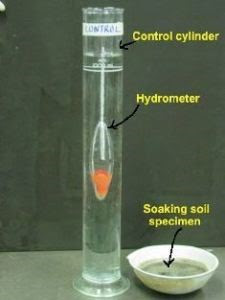SOIL REPORT: Hydrometer test
SOIL REPORT: Hydrometer test
Abstract: This blog post is a report of
laboratory soil analysis to determine the grain size of fine-grained soils.
Apparatus:
· Hydrometer made of glass and primarily consists of two parts:
o
A cylindrical stem with graduation marks
o
A bulb at bottom weighted with mercury
·
Dispersion
cup with a mechanical stirrer with complete accessories
·
Two
glass jars of 1-liter capacity
·
Deflocculating
agent (sodium Hexa metaphosphate solution prepared by dissolving 33g of sodium
Hexa metaphosphate and 7g of sodium carbonate in distilled water to make
one-liter solution)
·
Stopwatch
·
Thermometer
· Scale
Objective:
Hydrometers are designed to give the amount of soil, in grams, that
is still in suspension.
Measure
the relative density of a liquid.
Hydrometer
analysis is done for grain size analysis of fine-grained soils.
The
lower the density of the liquid the more the hydrometer will sink.
General Procedures:
·
The hydrometer
test is conducted in a sedimentation cylinder usually with 50 g of oven-dried
sample.
·
Sometimes 100-g
samples also can be used.
·
The sedimentation cylinder is 457 mm (18 in.)
high and 63.5 mm (2.5 in.) in diameter.
·
It is marked
for a volume of 1000 ml.
·
Sodium
hexametaphosphate generally is used as the dispersing agent.
·
The volume of
the dispersed soil suspension is increased to 1000 ml by adding distilled
water.
·
When a
hydrometer is placed in the soil suspension at a time t, measured from
the start of sedimentation it measures the specific gravity in the vicinity of
its bulb at a depth L.
·
The specific
gravity is a function of the number of soil particles present per unit volume
of suspension at that depth.
·
Also, at a time
t, the soil particles in suspension at a depth L will have a
diameter smaller than D.
·
The larger
particles would have settled beyond the zone of measurement.
·
By knowing the
amount of soil in suspension, L, and t, we can calculate the
percentage of soil by weight finer than a given diameter.
·
Note that L is the depth measured from
the surface of the water to the center of gravity of the hydrometer bulb at which
the density of the suspension is measured. The value of L will change
with time t.
Our Procedures:
·
We first take a
soil sample of 50 g
·
Then we take a
volume of 125 ml of dispersing agent (a solution of 1L distilled water + 40g
Sodium Hexametaphosphate)
·
We mix well the
sample for 3 minutes then we add water to reach 1000 ml
·
We put the
hydrometer inside the tube containing the sample and we take the reading after
15s, the 60s, 5min, 10min, and 30 min.
·
But because the
time was limited, we couldn’t wait to have the reading when almost all the soil
is settled
Data collection and
calculation:
Hydrometer
analysis is based on Stokes law. According to this law, the velocity at
which grains settles out of suspension, all other factors being equal, is
dependent upon the shape, weight, and size of the grain.
In case of
soil, it is assumed that the soil particles are spherical and have the same
specific gravity.
V is the
terminal velocity of sinking of a spherical particle, it is given by;
V = 1/18 [(Gs-Gw)/n)]
*D2
V = Terminal
velocity of soil particle (cm/s)
D = Diameter of
soil particle (cm)
Gs =
Specific gravity of soil particle
Gw =
specific gravity of water
n = viscosity
of water (g-s/cm2)
%finer = a*Rcp*100/ws
Dmin = k*(L/T) ^0.5
PT = (%passing sieve nb 200)/ 100 =
%finer*10/100
(Assume 10 %passing sieve nb 200)
Manual result:
M(soil) = 50 g
V(solution) = 125 ml
|
Time |
Hydrometer
reading (RCP) |
Corrected
length L(cm) |
k |
% Finer
in suspense (a=1) |
D
(mm) |
PT |
|
15s |
13cm |
14.2 |
0.0133 |
26 |
0.100236 |
2.6 |
|
60s |
12.8cm |
14.25 |
25.6 |
0.0502 |
2.56 |
|
|
5min |
12cm |
14.3 |
24 |
0.02249 |
2.4 |
|
|
10min |
11cm |
14.5 |
22 |
0.016015 |
2.2 |
|
|
30min |
10cm |
14.7 |
20 |
0.00931 |
2 |
%finer = RCP *100/50
D=k*(L/T) ^0.5 with L(cm) and T(min)
PT = %finer*10/100
Reference:
1)
Soil
lab (BAU)
2)
Book:
principles of geotechnical engineering (25th edition)



Comments
Post a Comment